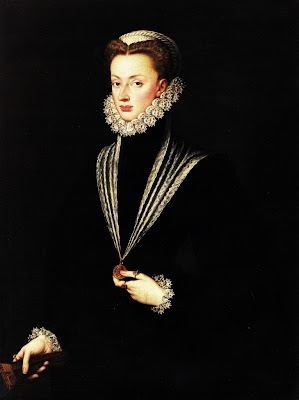Fundación Mapfre: Yves Saint Laurent Retrospective
11/20/11 – Paseo de Recoletas, 23
November turns out to be a wet month in Madrid. Every bar along the street glows invitingly. It’s not cold by midwestern standards, but dogs are wearing sweaters, and prams navigate the sidewalks like barges, their tiny passengers snug under clear plastic rain shields. Even on a rainy Sunday there’s plenty to do. Mapfre—a Spanish insurance company that sponsors cultural exhibits on a regular basis—is hosting a free retrospective on the influential French fashion designer Yves Saint Laurent (1936-2008).
 |
| 1965 |
The precocious Saint Laurent took over the House of Dior in Paris at age 21. He popularized the trapeze dress, safari jacket, tuxedo suit for women, and see-through evening wear. He scandalized the critics in 1971 with clothes reminiscent of prostitutes in Nazi-occupied Paris. Saint Laurent was also the first designer to use ethnic models in his runway shows.
There is little here about Yves the man. His disastrous experience in the French army during the Algerian war of independence, his addictions, and his private life are not on display. A replica of his modest work-table and studio shows only a few of Saint Laurent’s obsessions—a passion for art, and for his French bulldog “Moujik” (as documented by Andy Warhol, below).
Though he rarely traveled beyond his villa in Morocco, Saint Laurent drew inspiration from world cultures. I’m old enough to remember the splash he made in 1976 with his Russia-inspired collection.
When I arrived in Moscow in 1985, I think I expected to see Russian women dressed like that; in reality, the economy dictated a wardrobe of soviet drab—with the exception of fur hats, whose exuberance exceeded anything Saint Laurent could conjure. The lower floor of the exhibit chronicles the creative process, with four decades of Saint Laurent’s sketches and fabric samples. How dispiriting to see in detail the rise and fall of 1980s shoulder pads. During the flower of my youth, styles were so awful. And now Spain won’t let me forget: the 1980s gem El Coche Fantástico (Knight Rider, starring David Hasselhoff) plays daily on Spanish television.
On Sunday evening I saw “The Help” at Cinema Verdi, one of the few theaters in town that shows foreign movies with subtitles instead of dubbing. The American South has always seemed like another country, and in this film, set on the brink of the Civil Rights era, it’s truly alien. Ladies of the Junior League wear hometown versions of Dior’s “New Look,” their waists still as girdled as their outlook on life. I find myself wondering about attitudes toward race in Spain. During “The Help,” there were sniffles all around. Some things are universal.
The Yves Saint Laurent Retrospective runs until 8 January 2012.

















